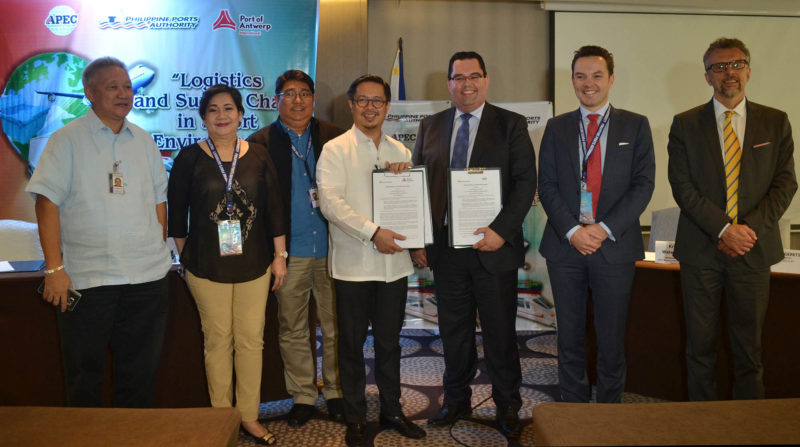
The Philippine Ports Authority (PPA) has agreed to engage in maritime capacity building and technical cooperation with the Port of Antwerp International (PAI) and Antwerp/Flanders Port Training Center (APEC).
PPA general manager Atty Jay Daniel Santiago, in a press conference after the signing of the memorandum of understanding (MOU) on October 19, said the cooperation will allow PPA to avail itself of the expertise, technologies, and skills that the modern Belgian port has to offer.
“This provides us the opportunities to be able to learn from them as we head towards ASEAN (Association of Southeast Asian Nations) integration so that we will be able to compete and adapt to the requirements of integration within the region,” Santiago said.
He added that through the MOU, PPA aims to simplify the country’s complex logistics and supply chain.
“It has been complicated in the Philippines especially, as we all know, the shipping industry, the port industry, and then the logistics industry, somehow have not been able to coordinate properly so that we will have a seamless supply chain,” he noted.
“So by learning from their (Port of Antwerp) experience, we will be able to rationalize the relationships between all of these industries comprising the supply chain,” Santiago said.
In a separate statement, Santiago said the MOU comes at a perfect time considering how complications in the country’s supply chain have bugged the delivery of goods for the past couple of years.
“This agreement will definitely give us the edge to further simplify and reduce the complexities in our overall supply chain considering that it is a challenge for a country composed of more than 7,000 islands,” Santiago explained.
“This is also in line with the thrust of the current administration in streamlining government processes to trim down the cost of doing business in the Philippines through faster delivery of government services.”
The Belgian delegates, led by APEC and PAI managing director Kristof Waterschoot, said the MOU is a means for Belgians to understand the plans and programs of the PPA and determine areas for collaboration while presenting the competitive advantages of Belgian technologies and services.
Waterschoot said port authorities today have to be “active players in the supply chain” and should not just be infrastructure managers “managing quay walls and port complex.”
“You have to create additional services, you have to work on added value,” Waterschoot pointed out.
He said one of the challenges for the Philippines “is not only connecting the islands but also directly linking to the international shipping system and trying to avoid a lot of transhipment in the area and in neighbouring countries and trying to directly connect major shipping and freight routes in the world.”
Santiago agreed that there “has to be a paradigm shift now on the focus and in the attention of the port authorities with respect (to) what is the key role or what the major role of ports (is) in particular countries, especially in the Philippines.”
“I think the port authorities should no longer just focus on port development… but take on a bigger role in so far as our participation in the entire supply chain…We should consider ourselves key part, we will play a major role in the entire supply system of the country,” Santiago explained.
The pact will last for a year, but may be extended or renewed, during which time both parties will sit down and strategize on how to concretize the relationship and move forward. The cost of implementing the MOU will be borne by each party, said Santiago.
Asked what Port of Antwerp hopes to gain, Waterschoot said “we want to set up also for our clients and our partners reliable supply chains.”
“I think for the moment, direct trade relations between Antwerp, Belgium, Europe, and the Philippines (are) still underdeveloped,” he noted.
He further declared that mutual cooperation facilitates trade between parties because both sides can influence or encourage their clients to look in the direction of their partners.
Port of Antwerp is one of the ports in the center of Europe, not only catering to Belgium but also to the Netherlands, Germany, France, northern Italy, and Switzerland.
The Belgian port is the second top port in Europe in cargo volume and the biggest port in added value of GDP contribution. It is also the biggest port for steel.
Waterschoot said trade relations between the Philippines and Port of Antwerp offer a lot of possibilities.
“We strongly see a positive outlook for the Philippines,” he continued.
Belgian exports to the Philippines are made up mostly of agricultural products, while imports by Belgium are mainly containerized goods, Waterschoot said.
The MOU includes technical cooperation in capacity building to enhance skills, abilities, and knowledge in port operation and to develop well-trained, knowledgeable, and able PPA professionals, while strengthening the traditional friendship between the parties and their ports.
Both sides also agreed to prepare a plan of cooperation based on mutual benefits and reciprocity involving port development, promotion, and customer service for enhanced maritime business and international trade.
Other matters discussed in the MOU include exchanges and cooperation in the development, modernization and management of ports; improvement of the legal and regulatory framework; increase in the profitability of transport and logistics operations and introduction of new management structures; and mutual attraction of investments in the development of port infrastructure and industrial and logistic port zones.
The pact calls for improvement of energy efficiency at port facilities and introduction of renewable energy sources; and joint conduct of research and consultancy projects for port, maritime and logistics services in the Philippines.
“With the dream of the Philippines to be a shipping super hub to compete with the likes of Hong Kong, Singapore, among others, this MOU puts the country a step closer (to) achieving that dream,” Santiago added. – Roumina Pablo




